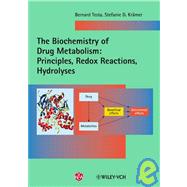The Biochemistry of Drug Metabolism Principles, Redox Reactions, Hydrolyses, 2 Volume Set
, by Testa, Bernard; Krä; mer, Stefanie D.- ISBN: 9783906390550 | 3906390551
- Cover: Paperback
- Copyright: 4/26/2010
Offering a conceptual and factual presentation of the metabolism of drugs and other xenobiotics, these two volumes distinctly focus on the biochemistry, with an emphasis on xenobiotic-metabolizing enzymes, their reactions and regulations. The first volume is divided into three parts. Part One begins by introducing xenobiotics in the broad context of physiological metabolism, and continues with an overview of the processes of drug disposition and metabolism. It then goes on to summarize the macroscopic and microscopic locations of drug metabolism in animals and humans. This is followed by an introduction to the all-important issue of the consequences of drug and xenobiotic metabolism, providing an initial overview of pharmacokinetic, pharmacological and toxicological consequences. The last chapter examines drug metabolism in the context of drug research, with a focus on medicinal chemistry. The second part is a major component of the book, corresponding to the role of oxidoreductases as major agents of metabolism. Cytochromes P450 receive particular attention, namely their multiplicity, structure, catalytic mechanisms, and the various reactions they catalyze, while other oxidoreductases are also presented, such as flavin monooxygenases, monoamine oxidases and other amine oxidases, aldehyde oxidase and xanthine dehydrogenase, peroxidases, and dehydrogenases-reductases. Each drug-metabolizing enzyme or enzyme family begins with an Enzyme Identity Card summarizing its nomenclature and biochemical essentials. Part Three begins with a survey of the classification, properties and catalytic mechanism of the innumerable hydrolases known or suspected to play a role in xenobiotic metabolism. The focus then shifts to a systematic presentation of the various substrates classes, namely carboxylic esters, amides and peptides, lactams and lactones, esters of inorganic acids, alkene and arene epoxides, and some miscellaneous hydrolyzable moieties. Volume Two contains the last four parts of this work. Part 4 is devoted to the huge field of conjugation reactions, with much information being given on transferases. As in the two preceding parts, each drug-metabolizing enzyme or enzyme family begins with an Enzyme Identity Card summarizing its nomenclature and biochemical essentials. The reactions examined here include methylation, sulfation, glucuronidation, acetylation, conjugation with glutathione, while there is also a rigorous presentation of the pivotal role of xenobiotic-coenzyme A conjugates as a crossroads to various metabolic reactions. The next part examines the consequences of drug and xenobiotic metabolism in a pharmacological and toxicological perspective, with due attention paid to full activation, as is found with prodrugs, and to the worrying case of xenobiotic toxification. Parts 6 and 7 cover the inter-individual and intra-individual factors that influence drug metabolism, starting with an introduction to evolutionary events leading to species differences in the metabolism of xenobiotics and to polymorphisms within a particular species. Focusing on humans, the most relevant polymorphic drug-metabolizing enzymes are discussed, concentrating on ethnic differences and on the consequences for the pharmacokinetic behavior of affected drugs, while also introducing sex-dependent metabolic reactions. The final part introduces the mechanisms leading to increases or decreases in enzyme activities as the concept of enzyme induction via nuclear receptors and the different mechanisms of enzyme inhibition are explained. With these basics in mind, various influencing factors are discussed, including physiological and pathological conditions, as well as drugs, nutrients and environmental agents with a special focus on drug-drug interactions. With a foreword






